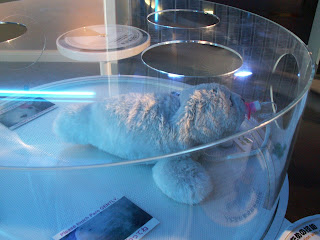The Future's Looking Innovative
Hidden around the back of Odaiba is a comparatively compact glass-framed museum: Miraikan - the National Museum of Emerging Science and Innovation. It's not an expensive visit, hands-on and well aimed for kids (or big kids) with glasses, or that way inclined.
It's impossible to be bored there, every table or display has a model to touch or a button to push. For example, in the Life Science arena, you can perform a technologically-advanced surgery, dissect the brain, or test how your reaction to stem-cell research measures up to the general consensus.
There are robots galore, with demonstrations throughout the day, including the famous ASIMO.
Or an artificial 'pet' which has shown to be just as successful in patient therapy as the real thing. This manatee responds appropriately depending on where you stroke him:
And you can explore the world and beyond, even entering a space habituation module, which comes with a toilet and shower. Messy.
The most interesting model for me was the 'reverse-mirror' trick, which is used for patients with a phantom limb. It's tough to explain; suppose someone lost an arm but had sensations it was still there. By tricking your mind with mirrors, so it appears your arm is there, you can control the pain and reduce it. Pretty amazing stuff.
For all the positives of the above, the main advice I can give is be prepared to feel frustrated at the organisation of the museum. There are shows, virtual theatres and a planetarium, but you can only choose one (or two depending on what you want to see) per ticket, and they sell out quickly. If you arrive over an hour after opening time, everything will be sold out. For example, we managed to snag a ticket to the virtual reality theatre showing of the cosmos and beyond, which only about twenty people can fit in, and there are only two shows a day. Kudos to the presenter who, with selecting the views we could see through our 3D glasses on a Playstation control, narrated the entire spiel for about 20 minutes - a remarkable feat which took some time I would assume. And for that reason I'm not surprised there are only two shows a day, the poor girl would be exhausted. But why not just record the speech and have the show running all day? This was the general set-up of every show.
The main-attraction MegaStar Planetarium was unspectacular and for boasting that it projected five million stars, it was less a show than a chemistry lesson; an overhead slide-show of how liquid and gas are dispersed in the Universe. I recommend giving it a miss and spending more time on other bits and pieces, such as going inside the cockpit of the world's deepest manned research submersible.
There is also an ever-changing special exhibition area. At the time of my visit, it was about aliens and the chance of life "out there"; including the Clangers and a display of the War of The Worlds radio play that caused mass-hysteria. Quirky, but not in line with the spirit of scientific aspiration and respect that the rest of the museum deserves. However, for all the criticism I give Japanese companies for not bothering consulting a single foreigner about spelling and grammar, the signs here were not only correct but well-written.
My favourite exhibit was the Geo-cosmos, I'll let the website explain:
Geo-Cosmos, which floats in the open space of the 1F Symbol Zone, is the symbol exhibit of the National Museum of Emerging Science and Innovation. Director Mamoru Mohri wanted to "share with many people the glowing image of the earth as seen from outer space." On the surface of this suspended sphere which is 6.5 meters in diameter are approximately 1 million LEDs through which it is possible to project various images relayed by satellite as the world's first spherical display. Through the direction of wind, amount of solar radiation, temperature and wind velocity, sounds are created in real-time by the mechanism where it is detected by sensors set on top of the roof.


The globe's display rotates in any direction and can even be controlled by hand, and was extraordinary just to watch. Different settings meant that you can see real-time weather displays, the surface of the moon, or even how Earth's temperature has rapidly increased and the estimation for the future.



(A quick stop at the Toyota showroom for the latest in laziness:*)

Overall, a fun and educational museum, with some layout flaws, finished off with a nice sunset:
 *Actually, I think it's more aimed at wheelchair users, but I can see a lot of theme parks being interested.
*Actually, I think it's more aimed at wheelchair users, but I can see a lot of theme parks being interested.




















No comments:
Post a Comment